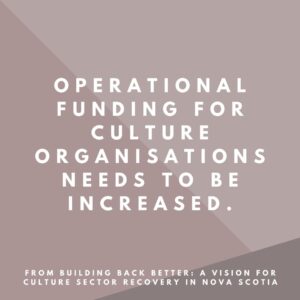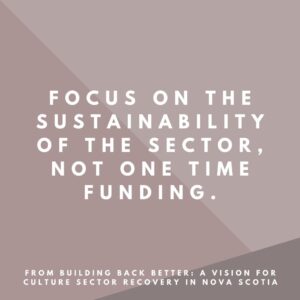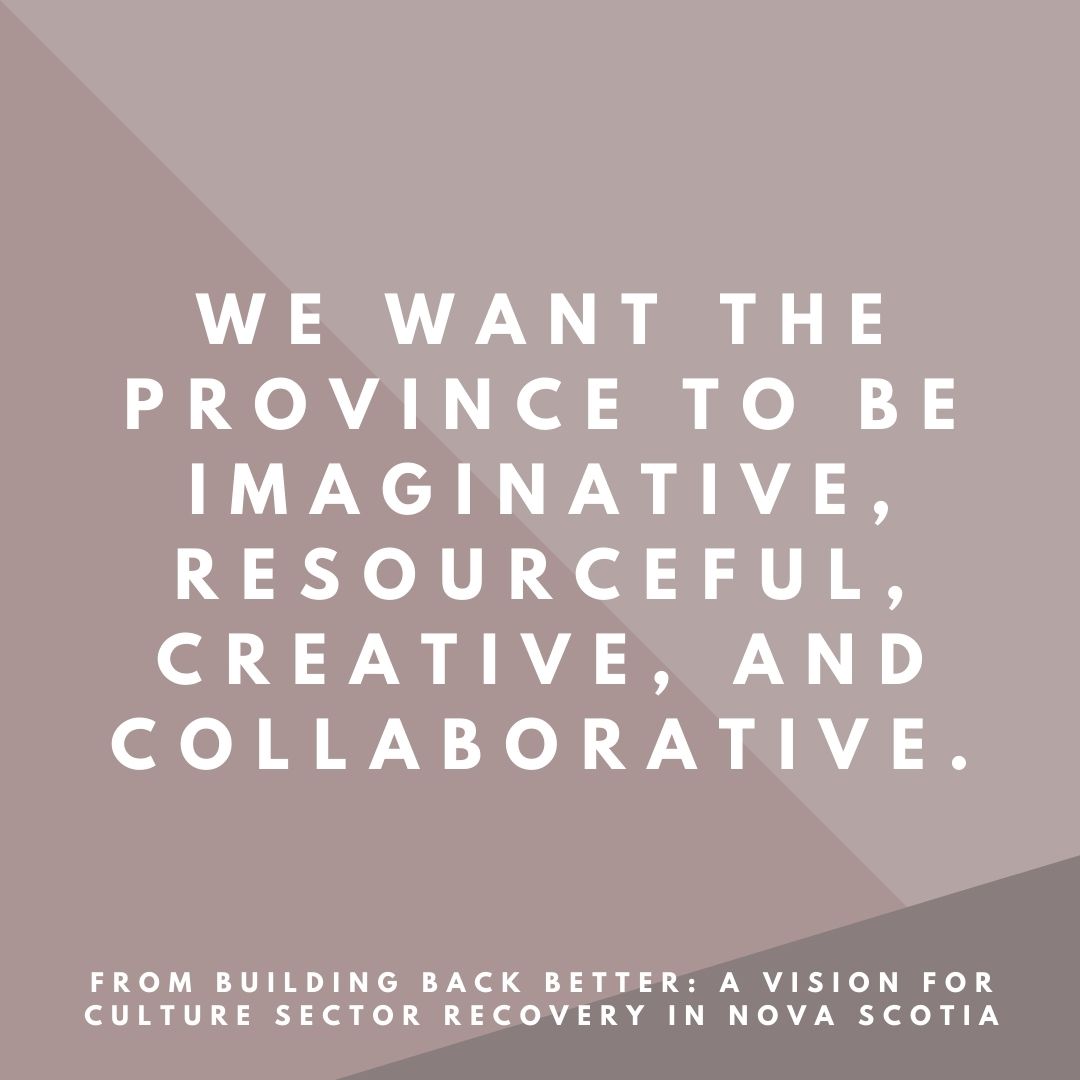
Exploring “Building Back Better: A Vision for Culture Sector Recovery in NS”
Arts Nova Scotia and Creative Nova Scotia Leadership Council has published a new report entitled Building Back Better: A Vision for Culture Sector Recovery in Nova Scotia.
As Nova Scotia prepares for post-COVID-19 recovery under new leadership, the culture sector must be an essential part of those plans. This pandemic has presented an opportunity to prioritize the culture sector as having an integral role in the province. VANS will be sharing some highlights and recommendations from Building Back Better: A Vision for Culture Sector Recovery in Nova Scotia put together by Arts Nova Scotia and Creative Nova Scotia Leadership Council in consultation with 200 stakeholders from across the cultural industries. Executive Director of Visual Arts NS, Benny Welter-Nolan, was active in these discussions bringing forth feedback collected from the visual arts community. Read the full report here.
“Operational funding for culture organisations needs to be increased.” – Building Back Better: A Vision for Culture Sector Recovery in Nova Scotia
Despite inflation, rising infrastructure costs, emerging urgent priorities, and the pressing demands posed by a global pandemic, operational funding has not been increased in more than 20 years. This presents a barrier to progress for the sector, preventing organisations from developing forward-thinking models of sustainability, addressing prescient issues around equity, diversity, and inclusion.
Expanding to a multi-year approach to funding – a 3 to 5 year cycle, for example – provides organisations with the stability and confidence necessary to engage in multi-year planning that emphasizes growth, creativity, better partnerships, and enhancement of quality of life for sector professionals and, indeed, for all Nova Scotians. Read the full report here.
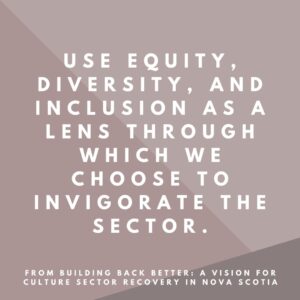 “Use equity, diversity, and inclusion as a lens through which we choose to invigorate the sector.”- Building Back Better: A Vision for Culture Sector Recovery in Nova Scotia
“Use equity, diversity, and inclusion as a lens through which we choose to invigorate the sector.”- Building Back Better: A Vision for Culture Sector Recovery in Nova Scotia
Across the sector, there is a strong desire to be more inclusive of all Nova Scotian cultures and voices. This means creating more opportunities for marginalized communities and ensuring their participation is grounded in authenticity. Directly funding EDI initiatives, creating more robust mentorship programs, and prioritizing the development of these communities will help reorient the sector and create spaces where marginalized communities can define their own strategies for inclusion and real participation, helping to undo complex harm and build bridges to new, citizen-driven modes of community harmony.
“Focus on the sustainability of the sector, not one time funding.” – Building Back Better: A Vision for Culture Sector Recovery in Nova Scotia
COVID-19 put a significant strain on human resources throughout the culture sector. Many organisations sacrificed their day-to-day duties to pursue emergency funds that allowed them to simply keep the doors open. Often, these emergency funds were one-time only offerings meaning that cultural organisations and artists spent more time on survival than on sustainability. Increasing core operational funding and creating new programs focused on a longer-term vision for the sector would help to advance growth of the cultural industries in a meaningful way while also promoting sustainability. Read the full report here.
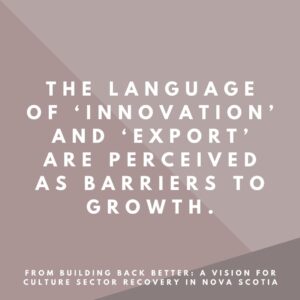 “The language of ‘innovation’ and ‘export’ are perceived as barriers to growth.” – Building Back Better: A Vision for Culture Sector Recovery in Nova Scotia
“The language of ‘innovation’ and ‘export’ are perceived as barriers to growth.” – Building Back Better: A Vision for Culture Sector Recovery in Nova Scotia
The sector concerns about single-project funding also extended to the language on which those programs are often hinged. Many stakeholders believe requiring new projects to be presented through a lens of ‘innovation’ stifles sustainability and impedes long-term growth, particularly in a time where they are simply trying to survive. ‘Export’ initiatives must also be refocused to concentrate on the growth of the whole sector. More must be done to help stakeholders at all levels achieve this status. Recovery strategies, therefore, need to foster more creation, more artist development, and more opportunities for emerging cultural producers at a grassroots level so that when we get to a point where we are once again able to focus on export and export missions, Nova Scotia has a much bigger pool of offerings.
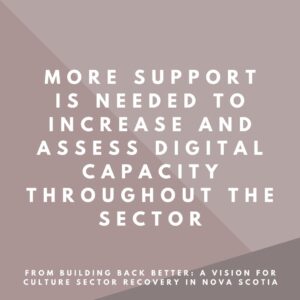 “More support is needed to increase and assess digital capacity throughout the sector.”- Building Back Better: A Vision for Culture Sector Recovery in Nova Scotia
“More support is needed to increase and assess digital capacity throughout the sector.”- Building Back Better: A Vision for Culture Sector Recovery in Nova Scotia
While the ‘pivot to digital’ was adapted by many in the culture sector throughout the pandemic, this strategy did not work for everyone. Artists and organisations in rural communities, for example, did not have equitable access to high speed internet that allowed them to participate in this revised marketplace. For those who did opt to participate in this new digital landscape, many found themselves having to learn a brand new skill set, buying new equipment to create high quality content, and spending time applying for digital-specific one-time-only project funding.
 “Reposition culture as a primary economic driver for COVID-19 recovery” – Building Back Better: A Vision for Culture Sector Recovery in Nova Scotia
“Reposition culture as a primary economic driver for COVID-19 recovery” – Building Back Better: A Vision for Culture Sector Recovery in Nova Scotia
Government also has a key role to play in choosing to put culture front and center in its recovery efforts. In the short-term, live events, performing arts, and cultural activities will be key drivers in attracting visitors to the province and in encouraging Nova Scotians to spend money here at home. The amount allocated for tourism and marketing to stimulate the economy during this recovery period should therefore be matched with investment in the culture sector
In the long-term, increased investment across the sector also fosters the potential to increase our capacity of cultural offerings overall, making Nova Scotia an even more appealing place not only to visitors, but also to prospective new businesses, emerging professionals, international students, and more.

